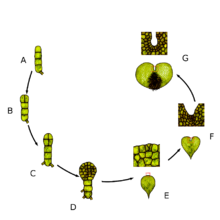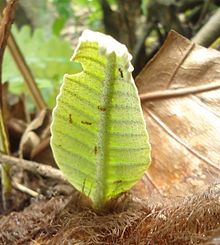- Drynaria
-
Basket ferns
Temporal range:
Piacenzian to Present
Cultivated Drynaria rigidula in Florida Scientific classification 
Kingdom: Plantae Division: Pteridophyta Class: Polypodiopsida/Pteridopsida
(disputed)Order: Polypodiales (unranked): Eupolypods I Family: Polypodiaceae Subfamily: Polypodioideae Tribe: Drynarieae Genus: Drynaria
(Bory) J. Sm.[1]Species See text

Drynaria is widespread in the Old World tropics. Synonyms[2] - Polypodium L. subgen. Drynaria Bory
- Saccopteris Alderw.
Drynaria, commonly known as basket ferns, is a genus of ferns in the family Polypodiaceae. It contains around 16 species and one natural hybrid.
Basket ferns are epiphytic or epipetric and are native to tropical Africa, South Asia, East Asia, Southeast Asia, Australia, and Oceania. Some species are economically important as medicinal plants.
Contents
Description
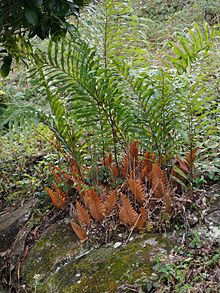 Drynaria rigidula growing on rocks in Australia. The fertile foliage fronds are large and dark green, the smaller brown sterile nest fronds are clustered at their bases.
Drynaria rigidula growing on rocks in Australia. The fertile foliage fronds are large and dark green, the smaller brown sterile nest fronds are clustered at their bases.
Basket ferns are characterized by the presence of two types of fronds, fertile foliage fronds and sterile nest fronds. The dark green foliage fronds are large, 2–4 feet (0.61–1.2 m) long, with elongated stalks. They are deeply lobed or pinnate, winged, and bear sori (structures producing and containing spores) on the bottom surfaces.[3]
The nest fronds are smaller rounded leaves basal to the foliage fronds. They do not bear sori and are persistent, not being shed after turning brown and dying.[3] They form a characteristic 'basket' that collect litter and organic debris, hence the common name.[4] The collected debris decompose into humus, providing the plants with nutrients it would otherwise not have received from being suspended above the ground.[5][6]
Both frond types grow from rhizomes typically anchored to a tree or a rock.[7][8] The rhizomes of Drynaria are creeping and densely covered in brown scales.[3]
Habitat and distribution
Basket ferns are epiphytic (growing on trees) or epipetric (growing on rocks). They can also sometimes be found in man-made structures like brick walls.[9] They are found in wet tropical environments, usually in rainforests.[4] Their native range extends from equatorial Africa to tropical South and East Asia, Southeast Asia, Australia, and Oceania.[10]
Life cycle
Like other spore-bearing plants, Drynaria exhibits metagenesis or the alternation of generations. One generation being the diploid multicellular sporophyte (the phase where the plant is most familiar), and the other being the haploid multicellular gametophyte (the phase where the plant is known as a prothallus). Gametophytes develop from spores released by mature sporophytes; while sporophytes, in turn, develop from the fusion of gametes produced by mature prothalli.[9][11]
Drynaria lends its name to a certain type of prothallial germination, the 'chlorophyllous cells with one or more rhizoids at the base cell. The tipmost cell divides repeatedly by cross-walls, forming a broad spatulate (spoon-shaped) prothallial plate. One of the cells at the top margin of the prothallus then divides obliquely when it has 5, 10, or more cells across its width. This results in an obconical meristematic cell. Division by this type of cell is parallel to each other and perpendicular to the rest of the cells, forming rows. This eventually results in the formation of a notch at the anterior edge of the prothallus, giving it a roughly heart-shaped appearance (cordate).[12]
The cordate prothallus are usually smaller with thinner midribs than that of other members of Polypodiaceae. They are also usually more sparsely haired, with some prothalli rarely having multicellular hair. They mature after six to nine months, and finish their life cycle at around a year. The gametophytes produce male (antheridium), and female (archegonium) gametes. The gametes fuse, forming the diploid sporophyte, the 'fern' part of the life cycle.[9][11][12]
Drynaria also naturally exhibits apospory, the production of a gametophyte not from spores, but directly from the vegetative cells of the sporophytes. Their leaves can develop prothalli under dim light and sporophytic buds in strong light.[13]
Ecology
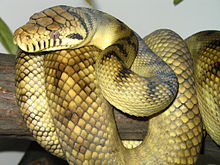 Amethystine pythons (Morelia amethistina) of Australia commonly seek shelter in Drynaria rigidula
Amethystine pythons (Morelia amethistina) of Australia commonly seek shelter in Drynaria rigidula
Drynaria, like some other genera of ferns (including Polybotrya and Polypodium), possess specialized nectar-secreting structures (nectaries) on the bases of the frond lobes or the underside of the fronds. The produced nectar is rich in sugars and amino acids.[14]
Their function may be to attract ants (or other organisms) for protection or for spore dispersal. They may also be simply excretory organs (hydathodes), used for exuding surplus metabolic products.[14] The ant species Iridomyrmex cordatus is commonly associated with D. quercifolia, in addition to other epiphytic plants.[15]
In Australia, Drynaria rigidula serve as shelter for amethystine pythons (Morelia amethistina) and scrub pythons (Morelia kinghorni).[16] As much as 81% of sightings of the snakes in one study were in large individuals of D. rigidula located about 17–40 m (56–130 ft) above the ground. Snakes seek shelter in D. rigidula more frequently during the colder seasons.[17]
In the 19th century, Indigenous Australians were documented by the Norwegian explorer Carl Sofus Lumholtz to have hunted pythons regularly during the winter months by climbing up to individuals of D. rigidula.[18]
The large rhizome mass of Drynaria can also serve as growing substrates for other plants like the ribbon fern (Ophioglossum pendulum).[19] Due to their ability to preserve moisture and persistence even after death, the nest leaves of Drynaria are also fertile hosts to a large number of water-borne fungi.[20]
Classification
Basket ferns are classified under the tribe Drynarieae, subfamily Polypodioideae, of the family Polypodiaceae. Species belonging to Drynaria were once classified under the genus Polypodium (rockcap ferns), under the subgenus Drynaria.[2][21]
Species
The following is the list of accepted species classified under the genus.[22] Species marked with † are extinct.
- Drynaria bonii H. Christ
-
- Native to India, Southeast Asia, and China. One of the smallest species of Drynaria, it can be distinguished by rounded nest fronds. The foliage fronds are pinnatesect with few widely separated lobes. The sori are arranged in two irregular rows between the secondary veins.[23]
- †Drynaria callispora Su, Zhou et Liu
-
- Extinct species from the Piacenzian age of China. See section below.
- Drynaria delavayi H. Christ
-
- Native to Tibet, China, Bhutan, and Myanmar. Nest fronds pinnatilobed with wavy margins. Foliage fronds are deeply pinnatifid, with 7 to 9 pinnae. Sori are large in comparison to the size of the lobes and arranged in two rows on both sides of the main rib and in between the secondary veins. Closely related to D. sinica.[24]
- Drynaria descensa Copel.
-
- Native to the Philippines. Similar to D. bonii but has smaller nest fronds, less than 2.5 cm (0.98 in) wide, with slightly scalloped margins. The foliage fronds are wavy.[23]
- Drynaria involuta Alderw.
 Drynaria laurentii in the Old Botanical Garden of Göttingen University.
Drynaria laurentii in the Old Botanical Garden of Göttingen University.
- Drynaria laurentii (H. Christ) Hieron.
-
- Commonly known as ibandibandi.[27] It is native to equatorial Africa, from Cameroon to the Democratic Republic of the Congo.[28]
- Drynaria mollis Bedd.
- Drynaria parishii (Bedd.) Bedd.
- Drynaria propinqua (Wall. ex Mett.) Bedd.
-
- Native to Nepal, Bhutan, India, Southeast Asia, and China. A medium-sized species, it can be distinguished by deeply pinnatifid on both the foliage and nest fronds, with lobes that taper to a sharp point. The sori are arranged in two rows on each side of the primary rib of each lobe and in between the secondary veins.[23][3]
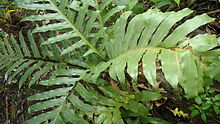 Drynaria quercifolia from the Philippines.
Drynaria quercifolia from the Philippines.
- Drynaria quercifolia (L.) J. Sm.
-
- Commonly known as the oak-leaf fern, pakpak lawin, gurar, koi hin, ashvakatri, or uphatkarul.[30] It is native to India, Southeast Asia, Malaysia, Indonesia, the Philippines, New Guinea, and Australia. It is a large species with deeply pinnatifid foliage fronds. The nest fronds resemble the leaves of oaks, hence the common name. The sori are either scattered or arranged in two regular rows in between the secondary veins.[23]
- Drynaria rigidula (Sw.) Bedd.
-
- Commonly known simply as the basket fern. It is native to Southeast Asia, China, Malaysia, Indonesia, the Philippines, Australia, New Guinea, and the southeastern Pacific Islands. Easily recognizable by being the only species in the genus with 1-pinnate foliage fronds. The lobes are narrow, taper to a sharp point, and are narrowly-winged at their attachment to the rachis. Sori are arranged in two rows along the primary vein of each lobe. Includes the cultivar Drynaria rigidula 'Whitei'.[23]
- Drynaria roosii Nakaike
-
- Commonly known as Gu-Sui-Bu. It is native to East Asia. Sterile nest fronds are rounded shallowly-lobed reddish-brown fronds overlapping each other. The fertile fronds are larger and deeply lobed. They bear 1 to 3 sori arranged on both sides of the central rib.[31][8][32] Formerly known as Drynaria fortunei.[33]
- Drynaria sinica Diels
- Drynaria sparsisora (Desv.) T. Moore
-
- Commonly known as simbar layangan. Native to Southeast Asia, Malaysia, Indonesia, New Guinea, and Australia. A large species, it is similar to D. quercifolia but has smaller and stiffer foliage fronds. The sori are also smaller and arranged irregularly.[23]
- Drynaria volkensii Hieron.
-
- Native to tropical Africa including Cameroon, Rwanda, Kenya, Burundi, Tanzania, Sudan, Ethiopia, Somalia, Zambia, Malawi, and Mozambique. Nest fronds are pinnatifid with acute to obtuse narrow lobes. Foliage fronds are pinnatifid and deeply and narrowly lobed. Sori arranged close to the main rib, about 3 mm (0.12 in) apart.[36]
- Drynaria willdenowii (Bory) T. Moore
-
- Native to Mauritius and Madagascar.[37][38]
- Drynaria × dumicola Bostock
-
- A natural hybrid of D. sparsisora and D. rigidula[39] Found in Queensland, Australia.[40]
Traditional medicine
Extracts from the rhizomes of some Drynaria species are used extensively in traditional medicine.[41][42] In China, Taiwan, Vietnam, Thailand, and Laos, the rhizomes of Gu-Sui-Bu Drynaria roosii (more frequently cited by Asian authors by its synonym Drynaria fortunei),[33] are commonly used to treat bone injuries.[9][43] Its common name literally means "mender of shattered bones" in Chinese.[44] Another species, the oak-leaf fern (Drynaria quercifolia) is used similarly in South Asia and Maritime Southeast Asia.[11][45]
Medical research
Numerous ethnopharmacological studies have been conducted into the properties of Drynaria.[11][9] In agreement with their use in traditional medicine, several studies have shown that basket ferns (D. roosii in particular) are effective in preventing resorption of bone cells and osteoporosis,[43][46] increases bone density, and have therapeutic effects on bone healing.[47][48][49] They have also been shown to possess a wide range of antimicrobial activity.[43][50][51]
Conservation
Species of Drynaria commonly used in traditional medicine like D. roosii and D. quercifolia are in danger of being overexploited. None of the species are currently cultivated for the alternative medicine industry.[11][9]
Drynaria are also considered endangered in some areas (like in New South Wales, Australia), due to threats of habitat loss and low population numbers.[11][52]
Evolution and fossil record
In 2010, twelve well-preserved fossil specimens of Drynaria were described from the Sanying Formation of the Yangjie coal mine of China. Named Drynaria callispora, it comes from the Piacenzian age of the Pliocene epoch (about 3.6 to 2.5 million years ago).[53]
The fossil record of Drynaria and drynarioids is not very well documented due to the typically poor preservation of fossils recovered. Previous fossil species assigned to Drynaria include Drynaria astrostigma, D. dura, and D. tumulosa from the Cenomanian of the Czech Republic; and D. durum, all assigned tentatively to the genus in 1899. The arrangement and type of their sori, however, indicate that they are members of the family Matoniaceae instead.[53]
Outside the genus, Protodrynaria takhtajani from the Eocene-Oligocene boundary of Kursk Oblast, Russia shows some affinities to Drynaria but only distantly. The only other reasonably convincing fossil remains of drynarioids aside from D. callispora was a specimen named Polypodium quercifolia recovered in 1985 from the Late Miocene (23.03 to 5.332 million years ago) of Palembang, Indonesia. These were later transferred to the living species Aglaomorpha heraclea. It remains, as of 2011, the oldest known drynarioid.[53][38]
Below is a reconstruction of the evolution of species of Drynaria and closely related genera Aglaomorpha and Selliguea based on combined morphological and molecular phylogenetic data (Janssen & Schneider, 2005). Drynaria is likely to be paraphyletic, in contrast to Aglaomorpha, another genus which possess specialized humus-collecting structures.[54]
← → Aglaomorpha spp.
Drynaria delavayi
Drynaria mollis
Drynaria sinica
Drynaria laurentii
Drynaria volkensii
Drynaria pleurodioides
Drynaria willdenowii
Drynaria quercifolia
Dryaria sparsisora
Drynaria involuta
Drynaria descensa
Drynaria bonii
Drynaria parishii
Dryaria propinqua
Dryaria rigidula
→ Selliguea and Arthromeris spp.
See also
- Platycerium – staghorn or elkhorn ferns
- Asplenium – spleenworts, bird's-nest ferns, and walking ferns
- Polypodium – rockcap ferns
References
- ^ "Drynaria (Bory) J. Sm.". Germplasm Resources Information Network (GRIN) online database. http://www.ars-grin.gov/cgi-bin/npgs/html/taxon.pl?4007. Retrieved July 27, 2011.
- ^ a b Michael Hassler & Brian Swale. "Family Drynariaceae, genus Drynaria; world species list.". Checklist of World Ferns. http://homepages.caverock.net.nz/~bj/fern/drynaria.htm. Retrieved July 27, 2011.
- ^ a b c d e Sarita Negi, Lalit M. Tewari, Y.P.S. Pangtey, Sanjay Kumar, Anita Martolia, Jeevan Jalal, & Kanchan Upreti (2009). "Taxonomic Studies On The Family Polypodiaceae (Pteridophyta) Of Nainital Uttarakhand". New York Science Journal 2 (5): 47–83. ISSN 1554-0200. http://www.sciencepub.net/newyork/0205/09_0798_paper1_ny0205.pdf. Retrieved July 28, 2011.
- ^ a b Russell Cumming & Jan Sked (August 21, 2006). "Drynaria & Platycerium: Interesting Fern Genera". Society for Growing Australian Plants. http://www.sgapqld.org.au/article34.html. Retrieved July 27, 2011.
- ^ Frederick Garrett Dickason (1946). "The Ferns of Burma". The Ohio Journal of Science 46 (3): 109–141. http://www.ibiblio.org/obl/docs2/ferns.pdf. Retrieved July 28, 2011.
- ^ Cliver Jermy & Roger Chapman (2002). Tropical Forest Expeditions. RGS-IBG Expedition Advisory Centre, Royal Geographical Society. p. 15. ISBN 090764984X. http://www.rgs.org/NR/rdonlyres/15DEB45A-FA2C-4C78-81A9-DCCEE06E1958/0/TropicalForestManual.pdf.
- ^ Sir William Jackson Hooker, Illustrated by Walter Hood Fitch (1862). Garden ferns; or, Coloured figures and descriptions of a selection of exotic ferns adapted for cultivation in the garden. http://books.google.com.ph/books?id=P0sDAAAAQAAJ&hl=en&pg=RA1-PA5#v=onepage&q&f=false.
- ^ a b Robert Lee Riffle (1998). The tropical look: an encyclopedia of dramatic landscape plants. Timber Press. p. 152. ISBN 9780881924220. http://books.google.com.ph/books?id=nrlPe2i98HEC&lpg=PP1&hl=en&pg=PA152#v=onepage&q&f=false.
- ^ a b c d e f H.C. Chang, D.C. Agrawal, C.L. Kuo, J.L. Wen, C.C. Chen and H.S. Tsay (2007). "In Vitro Culture of Drynaria fortunei, a Fern Species Source of Chinese Medicine "Gu-Sui-Bu"". In Vitro Cellular & Developmental Biology – Plant (Springer) 43 (2): 133–139. doi:10.1007/s11627-007-9037-6. ISSN 1475-2689. http://www.springerlink.com/content/f741539v31180513/. Retrieved July 31, 2011.
- ^ "Drynaria (Bory) J.Sm.". Global Biodiversity Information Facility. http://data.gbif.org/species/14760374. Retrieved July 27, 2011.
- ^ a b c d e f P.B. Mazumder, Bonani Mazumder, M. Dutta Choudhury, & G.D. Sharma (2011). "In Vitro Propagation of Drynaria quercifolia (L.) J. Sm., a Medicinal Fern.". Assam University Journal of Science & Technology: Biological and Environmental Sciences (Assam University) 7 (1): 79–83. ISSN 0975-2773. http://www.inflibnet.ac.in/ojs/index.php/AUJSAT/article/download/507/478. Retrieved July 31, 2011.
- ^ a b B. K. Nayar & S. Kaur (1971). "Gametophytes of Homosporous Ferns". The Botanical Review (The New York Botanical Garden) 37 (3): 295–396. ISSN 0006-8101. http://repository.ias.ac.in/24623/1/320.pdf. Retrieved July 31, 2011.
- ^ "The Opening Face of Vascular Plants: Pteridophyta". Competition Science Vision (Pratiyogita Darpan) 10 (113): 650–661. 2007. http://books.google.com.ph/books?id=C-gDAAAAMBAJ&lpg=PT95&ots=TrC5iszxMs&dq=drynaria%20type%20germination&hl=en&pg=PT95#v=onepage&q=drynaria&f=false. Retrieved July 31, 2011.
- ^ a b Suzanne Koptur, Alan R. Smith, & Irene Baker (1982). "Nectaries in Some Neotropical Species of Polypodium (Polypodiaceae): Preliminary Observations and Analyses". Biotropica (Association for Tropical Biology) 14 (2): 108–113. http://www2.fiu.edu/~kopturs/pubs/SK82fernnec.pdf. Retrieved July 28, 2011.
- ^ Victor Rico-Gray & Paulo S. Oliveria (2007). The Ecology and Evolution of Ant-Plant Interactions. Interspecific Interactions. The University of Chicago Press. p. 48. ISBN 9780226713489.
- ^ Jason Cummings, Michelle Martin and Anne Rogers (2006). "Quantifying the abundance of four large epiphytic fern species in remnant complex notophyll vine forest on the Atherton Tableland, north Queensland, Australia". Cunninghamia (Royal Botanic Gardens, Sydney & the National Herbarium of New South Wales) 9 (4): 521–527. http://www.rbgsyd.nsw.gov.au/__data/assets/pdf_file/0008/81593/Cun94Cum521.pdf. Retrieved July 30, 2011.
- ^ Alastair Freeman & Amanda Freeman (2009). "Habitat Use in a Large Rainforest Python (Morelia kinghorni) in the Wet Tropics of North Queensland, Australia". Herpetological Conservation and Biology (Herpetological Conservation and Biology) 4 (2): 252–260. http://www.herpconbio.org/Volume_4/Issue_2/Freeman_Freeman_2009.pdf. Retrieved July 30, 2011.
- ^ Alastair Freeman & Amanda Freeman (2007). "Giants in the Rainforest: A Radiotelemetry Study of the Amethystine Python in North Queensland, Australia". Iguana (International Reptile Conservation Foundation) 14 (4): 215–221. http://www.ircf.org/downloads/wwdigitalmembers/Iguana_14-4web.pdf#page=5. Retrieved July 30, 2011.
- ^ Elvianna Dorante-Day. "Ferns and Fern Allies". Bush Medicine Woman. http://bmw.atsiphj.com.au/index.php?option=com_content&view=category&layout=blog&id=95&Itemid=74&limitstart=8. Retrieved July 31, 2011.
- ^ Kishore Karamchand & Kandikerere R. Sridhar (2009). "Association of water-borne conidial fungi with epiphytic tree fern (Drynaria quercifolia)". Acta Mycologica (Swiss Association for International Cooperation) 44 (1): 19–27. http://www.ib-pan.krakow.pl/pubs-pdf/Acta%20Mycologica/2009/a19-27.pdf. Retrieved July 31, 2011.
- ^ D. J. Mabberley (2008). Mabberley's plant-book: a portable dictionary of plants, their classification and uses. Cambridge University Press. p. 690. ISBN 9780521820714. http://books.google.com.ph/books?id=9RyKKHtwXUYC&lpg=PP1&hl=en&pg=PA690#v=onepage&q&f=false.
- ^ "Drynaria". The Plant List v1.0. 2010. http://www.theplantlist.org/browse/P/Polypodiaceae/Drynaria/. Retrieved July 27, 2011.
- ^ a b c d e f Barbara Joe Hoshizaki & Robbin Craig Moran (2001). Fern Grower's Manual. Timber Press. p. 294–196. ISBN 9780881924954. http://books.google.com.ph/books?id=Wq_-jexfHCcC&lpg=PP1&hl=en&pg=PA294#v=onepage&q&f=false.
- ^ Jun Wen. "Drynaria delavayi Christ". The Plants of Tibet, Life Desks. http://plantsoftibet.lifedesks.org/pages/18636. Retrieved July 31, 2011.
- ^ Peter Martin Rhind. Plant Formations in the Bornean BioProvince. Terrestrial Biozones. http://www.terrestrial-biozones.net/Paleotropic%20Vegetation/Bornean%20Vegetation.pdf.
- ^ "Polypodiaceae Drynaria involuta Alderw.". The International Plant Names Index. http://www.ipni.org/ipni/idPlantNameSearch.do;jsessionid=D5D452BF23BE6F4A94C6C9646619F930?id=17247000-1&back_page=%2Fipni%2FeditAdvPlantNameSearch.do%3Bjsessionid%3DD5D452BF23BE6F4A94C6C9646619F930%3Ffind_infragenus%3D%26find_isAPNIRecord%3Dtrue%26find_geoUnit%3D%26find_includePublicationAuthors%3Dtrue%26find_addedSince%3D%26find_family%3DPolypodiaceae%26find_genus%3D%26find_isGCIRecord%3Dtrue%26find_infrafamily%3D%26find_rankToReturn%3D%26find_publicationTitle%3D%26find_authorAbbrev%3D%26find_infraspecies%3D%26find_includeBasionymAuthors%3Dtrue%26find_modifiedSince%3D%26find_isIKRecord%3Dtrue%26find_species%3D%26output_format%3Dnormal. Retrieved July 31, 2011.
- ^ Karsten Legère (2009). Masangu Matondo et al.. ed. Selected Proceedings of the 38th Annual Conference on African Linguistics. Cascadilla Proceedings Project. http://www.lingref.com/cpp/acal/38/paper2149.pdf. Retrieved July 28, 2011.
- ^ "Drynaria laurentii (C.Chr.) Hieron.". Vascular Plants of the Dzanga-Sangha Reserve. http://dzanga-sangha.myspecies.info/content/drynaria-laurentii-cchr-hieron. Retrieved July 31, 2011.
- ^ Jingxin Liu. "Drynaria parishii Bedd.". The Virtual Botanic Garden. http://www.virboga.de/Drynaria_parishii.htm. Retrieved July 31, 2011.
- ^ Eutiquio L. Rotaquio, Jr., Nobukazu Nakagoshi, & Ronaldo L. Rotaquio (2007). "Species Composition of Mangrove Forests in Aurora, Philippines – A Special Reference to the Presence of Kandelia candel (L.) Druve". Journal of International Development and Cooperation (Hiroshima University) 13 (1): 61–78. ISSN 1341-0903. http://ir.lib.hiroshima-u.ac.jp/metadb/up/kiyo/AN10482914/JIDC_13-1_61.pdf. Retrieved July 31, 2011.
- ^ A barefoot doctor's manual: a concise edition of the classic work of eastern herbal medicine. Running Press. 2002. p. 367. ISBN 9780762412501. http://books.google.com.ph/books?id=cc-8OcIgkeQC&lpg=PP1&hl=en&pg=PA367#v=onepage&q&f=false.
- ^ William Jackson Hooker (1864). Species filicum. William Pamplin. p. 95. http://books.google.com.ph/books?id=-XH1TlpK7c4C&hl=en&pg=PA95#v=onepage&q&f=false.
- ^ a b Stuart Lindsay, David J. Middleton, Thaweesakdi Boonkerd, & Somran Suddee (2009). "Towards a stable nomenclature for Thai ferns". Thai Forest Bulletin (Botany) (37): 64–106. http://web3.dnp.go.th/botany/PDF/TFB/TFB37/TFB37_8.pdf. Retrieved July 31, 2011.
- ^ Pasang Yonten Arya & Yonten Gyatso (1998). Dictionary of Tibetan materia medica. Motilal Banarsidass Publ.. p. 114. ISBN 9788120815674. http://books.google.com.ph/books?id=yp4yAWYb35QC&lpg=PP1&hl=en&pg=PA114#v=onepage&q&f=false.
- ^ "Drynaria sinica Diels". Germplasm Resources Information Network (GRIN) online database. http://www.ars-grin.gov/cgi-bin/npgs/html/taxon.pl?425023. Retrieved July 31, 2011.
- ^ "Entry for Drynaria volkensii Hieron. (family Polypodiaceae". JSTOR Plant Science. http://plants.jstor.org/flora/ftea005282. Retrieved July 31, 2011.
- ^ Jean Baptiste Bory de Saint-Vincent. "Holotype of Polypodium willdenowii Bory (family Pteridophyta)". JSTOR Plant Science. http://plants.jstor.org/specimen/p00266223. Retrieved July 31, 2011.
- ^ a b Thomas Janssen, Hans-Peter Kreier, & Harald Schneider (2007). "Origin and diversification of African ferns with special emphasis on Polypodiaceae". Brittonia (The New York Botanical Garden Press) 59 (2): 159–181. http://www.senckenberg.de/files/content/forschung/abteilung/botanik/phanerogamen1/janssen_janssenal_2007_africanferns.pdf. Retrieved July 31, 2011.
- ^ Polypodiaceae. Australian Plant Census (APC), Council of Heads of Australasian Herbaria. http://www.chah.gov.au/chah/apc/interim/Polypodiaceae.pdf.
- ^ "Polypodiaceae Drynaria × dumicola Bostock". The International Plant Names Index. http://www.ipni.org/ipni/idPlantNameSearch.do;jsessionid=447D04883EF7ECC7590E21889D662AFA?id=17571770-1&back_page=%2Fipni%2FeditAdvPlantNameSearch.do%3Bjsessionid%3D447D04883EF7ECC7590E21889D662AFA%3Ffind_infragenus%3D%26find_isAPNIRecord%3Dtrue%26find_geoUnit%3D%26find_includePublicationAuthors%3Dtrue%26find_addedSince%3D%26find_family%3DPolypodiaceae%26find_genus%3D%26find_isGCIRecord%3Dtrue%26find_infrafamily%3D%26find_rankToReturn%3D%26find_publicationTitle%3D%26find_authorAbbrev%3D%26find_infraspecies%3D%26find_includeBasionymAuthors%3Dtrue%26find_modifiedSince%3D%26find_isIKRecord%3Dtrue%26find_species%3D%26output_format%3Dnormal. Retrieved July 31, 2011.
- ^ Subhuti Dharmananda (July, 2010). "Drynaria and Dipsacus: yang tonifying herbs for bones, tendons, and brains". Institute for Traditional Medicine. http://www.itmonline.org/articles/drynaria/drynaria.htm. Retrieved July 30, 2011.
- ^ Karin Hilfiker (2008). "Improve livelihoods through market assessment and sustainable development of non-timber forest products (NTFPs) in two selected villages in the northern uplands of Vietnam.". Helvetas (Swiss Association for International Cooperation). http://www.helvetas.ch/Vietnam/wEnglish/Documents/Market_assessment_for_NTFPs_EN.pdf. Retrieved July 31, 2011.
- ^ a b c Eun-Kyung Jung (2007). "Antimicrobial Activity of Extract and Fractions from Drynaria fortunei Against Oral Bacteria". Journal of Bacteriology and Virology 37 (2): 61–68. http://synapse.koreamed.org/Synapse/Data/PDFData/0079JBV/jbv-37-61.pdf. Retrieved July 28, 2011.
- ^ Christopher Hobbs & Kathi Keville (2007). Women's Herbs, Women's Health. Book Publishing Company. p. 287. ISBN 9781570671524. http://books.google.com.ph/books?id=BvZX0ws63qUC&lpg=PP1&hl=en&pg=PA287#v=onepage&q&f=false.
- ^ Godofredo Stuart. "Pakpak lawin: Drynaria quercifolia Linn.". Philippine Medicinal Plants. http://www.stuartxchange.org/PakpakLawin.html. Retrieved July 27, 2011.
- ^ Ji-Cheon Jeong, Jae-Wook Lee, Cheol-Ho Yoon, Young-Choon Lee, Kang-Hyun Chung, Min-Gon Kim, & Cheorl-Ho Kim (2004). "Stimulative effects of Drynariae Rhizoma extracts on the proliferation and differentiation of osteoblastic MC3T3-E1 Cells". Journal of Ethnopharmacology (Elsevier) 96 (2005): 489–495. http://www.ibiblio.org/obl/docs2/ferns.pdf. Retrieved July 28, 2011.
- ^ Chung-King Hsu, Mei-Hsiu Liao, Yu-Tyng Tai, Shing-Hwa Liu, Keng-Liang Ou, Hsu-Wi Fang, I-Jung Lee, Ruei-Ming Chen (2011). "Nanoparticles prepared from the water extract of gusuibu (Drynaria fortunei J. sm.) protects osteoblasts against insults and promotes cell maturation". International Journal of Nanomedicine (Dovepress) 2011 (6): 1405–1413. doi:10.2147/IJN.S20473. http://www.dovepress.com/getfile.php?fileID=10482. Retrieved July 31, 2011.
- ^ Xin-Luan Wang, Nai-Li Wang, Yan Zhang, Hao Gao, Wai-Yin Pang, Man-Sau Wong, Ge Zhang, Ling Qin, & Xin-Sheng Yao (2008). "Effects of Eleven Flavonoids from the Osteoprotective Fraction of Drynaria fortunei (KUNZE) J. SM. on Osteoblastic Proliferation Using an Osteoblast-Like Cell Line". Chem. Pharm. Bull. (Pharmaceutical Society of Japan) 56 (1): 46–51. doi:10.2147/IJN.S20473. http://www.jstage.jst.go.jp/article/cpb/56/1/46/_pdf. Retrieved July 31, 2011.
- ^ Jui-Sheng Sun, Chun-Yu Lin, Guo-Chung Dong, Shiow-Yunn Sheu, Feng-Huei Lin, Li-Ting Chen, & Yng-Jiin Wang (2002). "The effect of Gu-Sui-Bu (Drynaria fortunei J.Sm) on bone cell activities". Biomaterials (Elsevier) 23 (2002): 3377–3385. http://ntur.lib.ntu.edu.tw/bitstream/246246/127994/1/27.pdf. Retrieved July 28, 2011.
- ^ M. Kandhasamy, K. D. Arunachalam, & A. J. Thatheyus (2008). "Drynaria quercifolia (L.) J.Sm: A potential resource for antibacterial activity". African Journal of Microbiology Research (Academic Journals) 2: 202–205. ISSN 1996-0808. http://www.academicjournals.org/ajmr/PDF/Pdf2008/Aug/Kandhasamy%20et%20al.pdf. Retrieved July 31, 2011.
- ^ A. Khan, E. Haque, M. Mukhlesur Rahman, A. Mosaddik, M. Rahman, & N. Sultana (2007). "Isolation of antibacterial constituent from rhizome of Drynaria quercifolia and its sub-acute toxicological studies". DARU Journal of Pharmaceutical Sciences (Tehran University of Medical Sciences) 15 (4): 205–211. ISSN 2008-2231. http://www.sid.ir/en/VEWSSID/J_pdf/85820070406.pdf. Retrieved July 31, 2011.
- ^ NSW Scientific Committee (October 4, 1998). "Drynaria rigidula (a fern) – endangered species listing". Office of Environment & Heritage, NSW Government. http://www.environment.nsw.gov.au/determinations/DrynariaRigidulaAFernEndSpListing.htm. Retrieved July 31, 2011.
- ^ a b c Tao Su, Frédéric M.B. Jacques, Yu-Sheng (Christopher) Liu, Jianying Xiang, Yaowu Xing, Yongjiang Huang, & Zhekun Zhou (2010). "A new Drynaria (Polypodiaceae) from the Upper Pliocene of Southwest China". Review of Palaeobotany and Palynology (Elsevier) 164 (2011): 521–527. doi:10.1016/j.revpalbo.2010.11.011. ISSN 0034-6667. http://faculty.etsu.edu/liuc/Su,%20Jacques,%20Liu%20et%20al.%202011.%20Pliocene%20Drynaria%20SW%20China.pdf. Retrieved July 30, 2011.
- ^ T. Janssen & H. Schrneider (2005). "Exploring the evolution of humus collecting leaves in drynarioid ferns (Polypodiaceae, Polypodiidae) based on phylogenetic evidence". Plant Systematics and Evolution (Springer-Verlag) 252: 175–197. doi:10.1007/s00606-004-0264-6. http://ntur.lib.ntu.edu.tw/bitstream/246246/127994/1/27.pdf. Retrieved July 28, 2011.
Categories:- Polypodiaceae
- Epiphytes
Wikimedia Foundation. 2010.


